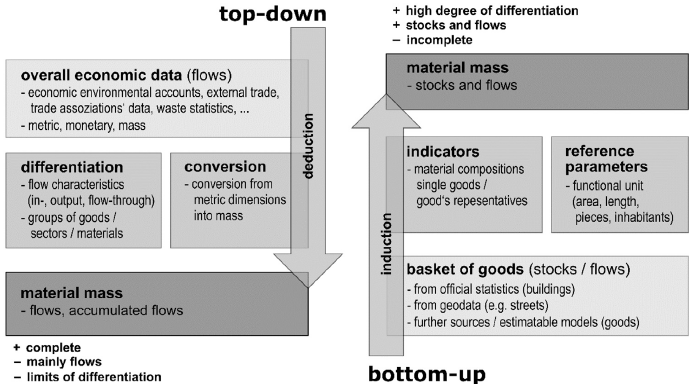Quantification of construction materials in existing buildings (material intensity)
Contents |
[edit] Overview
The existing building stock can be considered as an accumulation of physical material resources that could be used in the future to reduce the burden on primary materials.
This page presents a list of academic research that focusses on quantifying the materials found in existing buildings. There are typically two main approaches to material stock assessment and these are referred to as top-down and bottom-up (Figure 1). As explained by Marinova et al (2020), “the top-down approach calculates stocks at the aggregate level, as the result of net-additions-to-stock of a material over a period of time. The bottom-up approach divides the stock into categories of products or applications and estimates the stock by characterising each of its components with a material intensity ratio (e.g. kg/m2)”.
Figure 1 - Top-down and bottom-up perspectives (Schiller, Muller & Ortlepp, 2016, p.4)
Research on this topic ranges from individual developments, cities and regions to global assessments and covers a variety of building types (residential, commercial, etc.). The provided list is not exhaustive.
[edit] List of academic literature
[edit] References
Marinova, S., Deetman, S., van der Voeet, E. and Daioglou, V. (2020). Global construction materials database and stock analysis of residential buildings between 1970-2050. Journal of Cleaner Production, 247, 119146.
Schiller G., Müller, F. and Ortlepp, R. (2016). Mapping the anthropogenic stock in Germany: Metabolic evidence for a circular economy. Resources, Conservation and Recycling, 123, pp93-107.
[edit] Related articles on Designing Buildings
- Climate change.
- Circular economy.
- Disposal.
- End of life potential.
- Material efficiency.
- Material intensity.
- Mean lean green.
- Pre-demolition audit.
- Renewable energy.
- Recycling.
- Upcycling.
- Waste and Resources Action Programme WRAP.
- Waste hierarchy.
- Waste management plan for England.
- Waste.
- Wishcycling.
About the wiki
Anyone is welcome to use and contribute to the wiki in different ways.
[edit] Engaging with the wiki
You can:
- Contribute to existing articles
- Create articles
- Share articles through social media and other channels
- Contact the CIRCuIT project to let us know what you think and how we can improve
[edit] Add your own content
To contribute to or create an article, you can follow these steps:
- Register as a user
- Read through the editorial policy and guidance on writing and contributing to articles
- See the detailed help page on tips on writing wiki articles
- Try editing a test article
- If editing an article, select 'Edit this article' underneath the article title
- If creating a new article, select 'Create an article'. In the 'Select categories' area, expand the 'Industry context' list and tag 'Circular economy' to add your article to this wiki
[edit] Who is this wiki for?
The articles contain information on implementing circular economy approaches in construction that could be relevant to:
- Architects
- Construction contractors
- Designers
- Developers, owners, investors
- Engineers
- Landowners
- Manufacturers and supplier
- Universities and research
- Urban planners
[edit] About CIRCuIT
The Circular Economy wiki is supported by the Circular Construction in Regenerative Cities (CIRCuIT) project, which is funded by the European Union's Horizon 2020 research and innovation programme. CIRCuIT is a collaborative project involving 31 ambitious partners across the entire built environment chain in Copenhagen, Hamburg, Helsinki Region and Greater London. Through a series of demonstrations, case studies, events and dissemination activities, the project will showcase how circular construction practices can be scaled and replicated across Europe to enable sustainable building in cities and the transition to a circular economy on a wider scale.








Comments
[edit] To make a comment about this article, click 'Add a comment' above. Separate your comments from any existing comments by inserting a horizontal line.